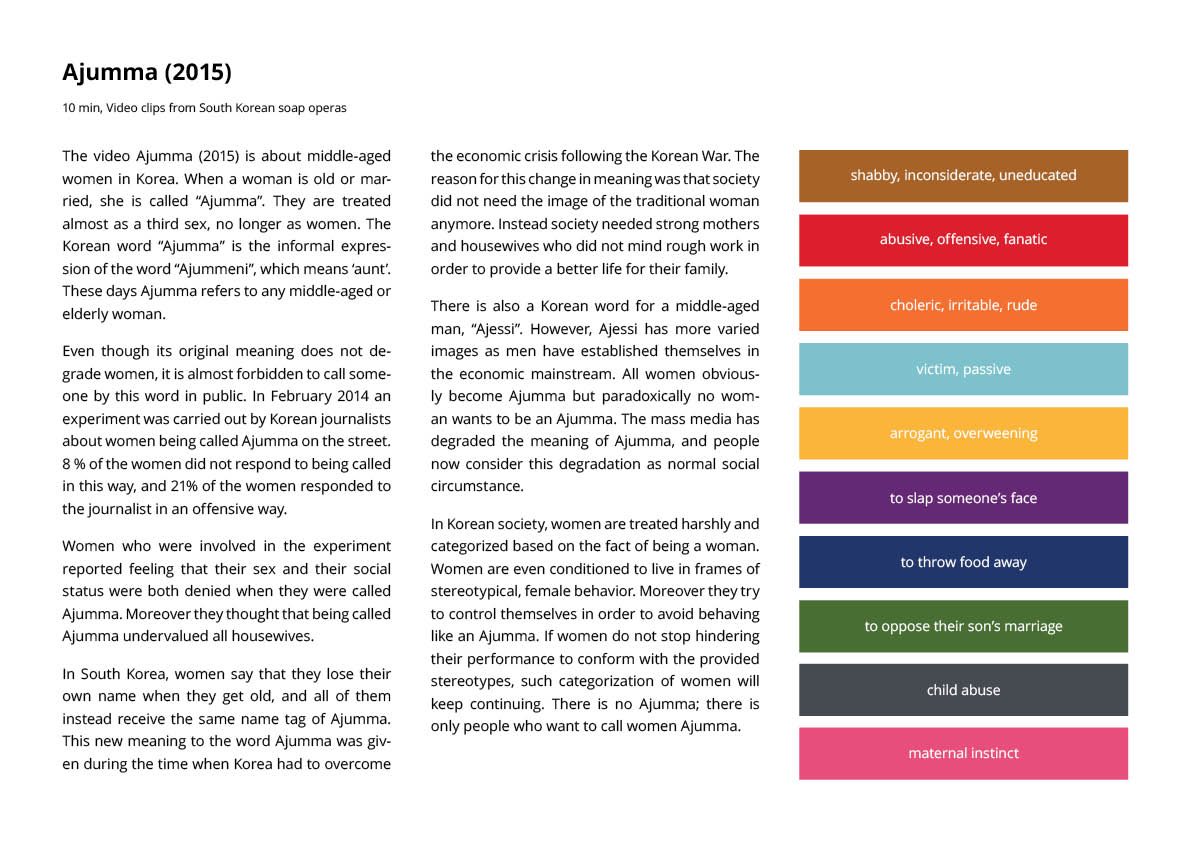Ajumma & Agassi: Images of Women in the South Korean Mass Media
Video installation,
144 cm x 117 cm x 0.3 cm
Video installation,
144 cm x 117 cm x 0.3 cm

Exbition at Xhibit in Vienna 2017
Intro
My interest is in the field of gender in South Korean mass media. In Korean mass media, field representations of women are still subordinated to male point of view. Korean mass media is an accurate description of Korean society. The mass media’s outdated images of women reflect the current state of gender (in)equality in South Korea.
For my diploma exhibition at the Xhibit, I presented two video works: Ajumma (2015) and Agassi (2017). My two videos show women who have lost their right to individuality and who have been balancing on a tightrope of immature, male demands. My two videos aim to examine gender in popular Korean culture in a new light through the use of Korean mass media images the original images. To show collected found footage of similar images has a ripple effect and makes it uncan- ny and at the same time. To compile such mass media images has a ripple effect. The videos first highlight the lack of TV roles available to women and then draw attention to the confining stereoty- pes Korean women must face when they are given TV roles.
The series of videos about
1. ‘Korean Middle-Aged Women’ / Ajumma (2015) and
2. ‘Korean Girls’ / Agassi (2017)
consist of found footage from the Korean public media. All of the found footages for my videos are taken from Youtube.


The video work Agassi (2017) shows how a sexual double standard divides women into two kinds of groups. This is a familiar dichotomy: women are labeled either as a saint or prostitute, a marriage partner of just a playing partner, a professional or an amateur.1
Every 1.5 days in South Korea a woman is killed by her boyfriend, husband or male acquaintance.2 This statistic shows that Korea’s societal misogyny has reached the uppermost limit. However, the Korean government does not accept such crimes as misogyny nor as crimes against women. They are seen only as private problems.
Since the end of the 1990s, policy on women’s education has been developed and gender equality in education has been established.3 Now within the same school district teenage girls receive the same education as teenage boys. However, there is still a difference between women and men in Korean society and culture. When a woman is young, she is treated like a saint or a prosti- tute. K-Pop is an example of this and is thus a theme I use for one of my videos.
In making the videos Ajumma (2015) and Agassi (2017), my position is that of an observer who has enough distance from the work to remain rational. Even though I collected and analyzed images, I tried to stay on the outside, maintaining a certain distance and developing an objective stance.
Information on the video installation

Exbition at Xhibit in Vienna 2017
All photos on the wall are from Korean show programs led only by men. In fact in South Korea, there are few show programs with women as hosts. Many show programs only include women as assistants or helpers which are traditional female roles within Korean society. These women are mostly coy, kind, wise, meek, and mild.
The photos of men are under the black acrylglass. Using the black acrylglass men exist in the video installation, at the same time they can not be dominant like always. The Videos of women have to seize the spotlight. This video installation create a synergy effect to watch the video works.
1. Cf.: Ueno Chizuko, ONNA GIRAI-NIPPON NO MISOGYNY, p.53
2. Korean Women Hot Line, http://hotline.or.kr/board_statistics/24845?ckattempt=2,
accessed on 14.09.2016
3. Cf.: The Transition of Korean Women’s Education, Jea-In Kim, Ae-Kyoung Yang, Hyeon-Lan Heo and Hyeon-Ok Yu, Published by Korean Women’s Development Institute, 2000
This project was supported by the Academy of Fine Arts Vienna
.